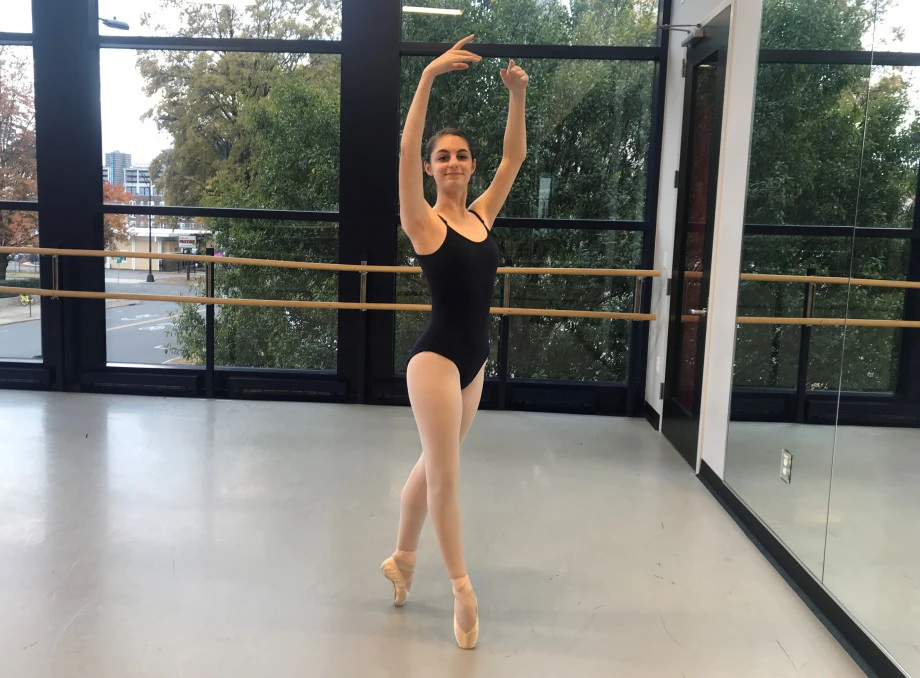The breathtaking holiday magic that Nutcracker brings to the stage can seem captivatingly alive. As Clara finds herself amid a terrifying battle between the Nutcracker and the Mouse King, she is transported to a whimsical world of powder-fresh snow, the Land of Sweets and the Sugar Plum Fairy. In the end, she wonders if it had all been a dream. The seemingly effortless dancing is part of the alluring genius and enchantment of the beloved ballet.
Mia is one of those dancers who bring Charlotte Ballet's Nutcracker to life. She’ll be the first to admit that the story’s enthralling charm is tougher than it looks to the audience, but to Mia, dancing Nutcracker (in the Wind in 2018) is an obligatory part of the holiday season. At 16 years old, she dances five days a week for 20 hours a week. Now in her thirteenth year in the ballet company, dancing to Mia is not just a past time, it’s a career goal and life passion. She will do anything to stay on her toes and one day dance in New York.
Compound Steps
In 2018, Mia began having pain in her feet at the Achilles tendons which affected her ankles, calves and right hip. She dances en pointe which puts a great deal of pressure on the feet, which translates into pressure in the lower legs and back. Even as she focused on stretching, her rigorous dance schedule was demanding and she couldn’t seem to find relief from the pain. Mia began working with Carol Green, PT COMT, physical therapist at OrthoCarolina Eastover (who herself is a former gymnast, dancer and instructor). Carol immediately noticed that Mia had weaknesses in her hip rotator and extensor muscles, which also meant that she had weakness in the ankles.
Carol recognized this pattern as she has seen it before in professional dancers and professional ice skaters she has treated in the past. Many people do not realize that if the hip muscles, especially the rotators are weak, the muscles down the rest of the leg will be weak as well. Dancers are high-end athletes, but can still have weaknesses in some areas that are not trained as much as others.
Hip rotator and extensor strengthening exercises with bands and pulleys were immediately prescribed for Mia. Most ballet dancers spend a lot of time on their toes, therefore the Achilles tendon coming from the gastrocnemius/soleus muscles into the heel gets overused and tight while other muscles get weak. Just stretching the gastrocnemius/soleus and Achilles is not enough; the other muscles which are weakened must be strengthened as well.
Recovery de Deux
Mia didn’t just have lower body weaknesses to tackle. Carol discovered that she also had core deficits. Dancers are usually very flexible but not always strong in the core. Mia also had an adverse neural tension of the right sciatic nerve, creating soft tissue as well as nerve problems which were addressed by doing some nerve gliding movements and soft tissue mobilization of the leg. With multiple issues to work on and a holiday performance looming around the corner, Carol and Mia quickly put a recovery plan into action.
Carol helped Mia by working on her core stabilization muscles, called the transverse abdominus and multifidus muscles to increase abdominal and low back strength. By doing exercises lying on the back, quadruped (on hands and knees) and on the stomach pulling the lower abdominal muscles in and backwards towards the spine, the core muscles were strengthened. The movements would help Mia know how to engage these muscles completely during her dance movements.
The plié, which may appear to some to be a simple bending of the knees, is actually far more complicated and helps ballerinas develop proper technique for dancing. Done repeatedly, it keeps a dancer’s tendons, muscles, joints and ligaments flexible and elastic. For Mia, it became a true struggle with her tight Achilles. Carol helped her by doing soft tissue mobilization and stretching of the Achilles and gastrocnemius muscles. Carol also had Mia use different types of equipment that challenge balance, muscle strength and core strength.
 | ||
Even though they were not in a dance studio, Mia performed her arabesques and Rond de Jambe while balancing on one leg on top of a Bosu ball, blue balance disc or wobble . These movements added challenge to prepare her for higher difficulty movements resembling the choreography of her dances. She used the mini trampoline to prepare for higher jumps and leaps with proper form. The Baps board was helpful in regaining her ankle motion and stretching of the Achilles tendons to allow for full plies without pain or restriction.
A Best Foot Forward
Recovery isn’t always easy, but hard work pays off. Mia has already noticed significant improvement in her strength and in her pain levels. With performances now underway for Nutcracker, recovery couldn’t have come at a more opportune time. While she’ll need to continue to manage her weaknesses and continue to build upon improving them, her physical therapy base taught her how to strengthen, stretch and most importantly maintain her progress.
Mia is done fighting battles for now… that is, at least until she encounters the Mouse King and Nutcracker.
Back




Leave a Comment